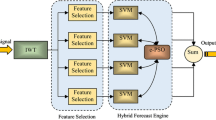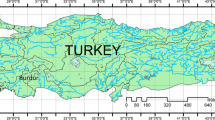Abstract
This paper presents a new prediction model based on empirical mode decomposition, feature selection and hybrid forecast engine. The whole structure of proposed model is based on nonstationarity and non-convex nature of wind power signal. The hybrid forecast engine consists of three main stages as; empirical mode decomposition, an intelligent algorithm and back propagation neural network. All parameters of proposed neural network will be optimized by intelligent algorithm. Effectiveness of the proposed model is tested with real-world hourly data of wind farms in Spain and Texas. In order to demonstrate the validity of the proposed model, it is compared with several other wind speed and power forecast techniques. Obtained results confirm the validity of the developed approach.








Similar content being viewed by others
References
Abdel-Aal RE, Elhadidy MA, Shaahid SM (2009) Modeling and forecasting the mean hourly wind speed time series using GMDH-based abductive networks. Renew Energy 34:1686–1699
Abedinia O, Amjady N (2015) Short term load forecast of electrical power system by radial basis function neural network and new stochastic search algorithm. Eur Trans Electr Power. https://doi.org/10.1002/etep.2160
Abedinia O, Ghadimi N (2013) Modified harmony search algorithm based unit commitment with plug-in hybrid electric vehicles. J Artif Intell Electr Eng 2(6):49–62
Abedinia O, Amjady N, Ghasemi A (2014) A new meta-heuristic algorithm based on shark smell optimization. Complex J (John Wiley). https://doi.org/10.1002/cplx.21634
Abedinia O, Amjady N, Ghadimi N (2017a) Solar energy forecasting based on hybrid neural network and improved metaheuristic algorithm. Comput Intell 34:241–260
Abedinia O, Bekravi M, Ghadimi N (2017b) Intelligent controller based wide-area control in power system. Int J Uncertain Fuzziness Knowl Based Syst 25(01):1–30
Ahmadian I, Abedinia O, Ghadimi N (2014) Fuzzy stochastic long-term model with consideration of uncertainties for deployment of distributed energy resources using interactive honey bee mating optimization. Front Energy 8(4):412–425
Amjady N, Keynia F, Zareipour H (2010) A new hybrid iterative method for short-term wind speed forecasting. Euro Trans Electr Power 20:1–15
Amjady N, Keynia F, Zareipour H (2011) Wind power prediction by a new forecast engine composed of modified hybrid neural network and enhanced particle swarm optimization. IEEE Trans Sustain Energy 2(3):265–276
Bagal H, Asadi et al (2018) Risk-assessment of photovoltaic-wind-battery-grid based large industrial consumer using information gap decision theory. Sol Energy 169:343–352
Eskandari Nasab M et al (2014) A new multiobjective allocator of capacitor banks and distributed generations using a new investigated differential evolution. Complexity 19(5):40–54
Gao W et al (2019) Different states of multi-block based forecast engine for price and load prediction. Int J Electr Power Energy Syst 104:423–435
Ghadimi N, Firouz MH (2015) Short-term management of hydro-power systems based on uncertainty model in electricity markets. J Power Technol 95(4):265
Ghadimi N et al (2018) Two stage forecast engine with feature selection technique and improved meta-heuristic algorithm for electricity load forecasting. Energy 161:130–142
Gollou A, Rahimi, Ghadimi N (2017) A new feature selection and hybrid forecast engine for day-ahead price forecasting of electricity markets. J Intell Fuzzy Syst 32(6):4031–4045
Hamian M et al (2018) A framework to expedite joint energy-reserve payment cost minimization using a custom-designed method based on mixed integer genetic algorithm. Eng Appl Artif Intell 72:203–212
Le Xie Y, Gu X, Zhu, Genton MG (2013) Short-term spatio-temporal wind power forecast in robust look-ahead power system dispatch. IEEE Trans Smart Grid 5(1):511–520
Leng H et al (2018) A new wind power prediction method based on ridgelet transforms, hybrid feature selection and closed-loop forecasting. Adv Eng Inform 36:20–30
Liu Y, Wang W, Ghadimi N (2017) Electricity load forecasting by an improved forecast engine for building level consumers. Energy 139:18–30
Maqsood I, Khan MR, Huang GH, Abdalla R (2005) Application of soft computing models to hourly weather analysis in southern Saskatchewan, Canada. Eng Appl Artif Intell 18(1):115–125
Mirzapour F et al (2017) A new prediction model of battery and wind-solar output in hybrid power system. J Ambient Intell Hum Comput 217:1–11
Mohammadi M et al (2018) Small-scale building load forecast based on hybrid forecast engine. Neural Process Lett 48(1):329–351
Sotavento Wind Farm (2018) [Online] http://www.sotaventogalicia.com
West Texas Wind Farm (2018) [Online] http://www.mesonet.ttu.edu/wind.html
Yeh WC (2013) New parameter-free simplified swarm optimization for artificial neural network training and its application in the prediction of time series. IEEE Trans Neural Netw Learn Syst 24(4):661–665
Yeh WC (2017) A squeezed artificial neural network for the symbolic network reliability functions of binary-state networks. IEEE Trans Neural Netw Learn Syst 28(11):2822–2825
Yeh WC, Yeh YM, Chang PC, Ke YC, Chung V (2014) Forecasting wind power in the Mai Liao Wind Farm based on the multi-layer perceptron artificial neural network model with improved simplified swarm optimization. Int J Electr Power Energy Syst 55:741–748
Author information
Authors and Affiliations
Corresponding author
Additional information
Publisher’s Note
Springer Nature remains neutral with regard to jurisdictional claims in published maps and institutional affiliations.
Rights and permissions
About this article
Cite this article
Mir, M., Shafieezadeh, M., Heidari, M.A. et al. Application of hybrid forecast engine based intelligent algorithm and feature selection for wind signal prediction. Evolving Systems 11, 559–573 (2020). https://doi.org/10.1007/s12530-019-09271-y
Received:
Accepted:
Published:
Issue Date:
DOI: https://doi.org/10.1007/s12530-019-09271-y




